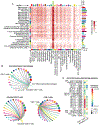Macrophage and CD8 T cell discordance are associated with acute lung allograft dysfunction progression
- PMID: 38367738
- PMCID: PMC11230518
- DOI: 10.1016/j.healun.2024.02.007
Macrophage and CD8 T cell discordance are associated with acute lung allograft dysfunction progression
Abstract
Background: Acute lung allograft dysfunction (ALAD) is an imprecise syndrome denoting concern for the onset of chronic lung allograft dysfunction (CLAD). Mechanistic biomarkers are needed that stratify risk of ALAD progression to CLAD. We hypothesized that single cell investigation of bronchoalveolar lavage (BAL) cells at the time of ALAD would identify immune cells linked to progressive graft dysfunction.
Methods: We prospectively collected BAL from consenting lung transplant recipients for single cell RNA sequencing. ALAD was defined by a ≥10% decrease in FEV1 not caused by infection or acute rejection and samples were matched to BAL from recipients with stable lung function. We examined cell compositional and transcriptional differences across control, ALAD with decline, and ALAD with recovery groups. We also assessed cell-cell communication.
Results: BAL was assessed for 17 ALAD cases with subsequent decline (ALAD declined), 13 ALAD cases that resolved (ALAD recovered), and 15 cases with stable lung function. We observed broad differences in frequencies of the 26 unique cell populations across groups (p = 0.02). A CD8 T cell (p = 0.04) and a macrophage cluster (p = 0.01) best identified ALAD declined from the ALAD recovered and stable groups. This macrophage cluster was distinguished by an anti-inflammatory signature and the CD8 T cell cluster resembled a Tissue Resident Memory subset. Anti-inflammatory macrophages signaled to activated CD8 T cells via class I HLA, fibronectin, and galectin pathways (p < 0.05 for each). Recipients with discordance between these cells had a nearly 5-fold increased risk of severe graft dysfunction or death (HR 4.6, 95% CI 1.1-19.2, adjusted p = 0.03). We validated these key findings in 2 public lung transplant genomic datasets.
Conclusions: BAL anti-inflammatory macrophages may protect against CLAD by suppressing CD8 T cells. These populations merit functional and longitudinal assessment in additional cohorts.
Keywords: CD8 T cell; acute lung allograft dysfunction; bronchoalveolar lavage; chronic lung allograft dysfunction; lung transplant; single cell RNA sequencing.
Published by Elsevier Inc.
Conflict of interest statement
Conflict of interest The authors declare no relevant conflicts of interest.
Figures







Comment in
-
Alveolar macrophage-CD8 T cell interactions after acute lung allograft dysfunction: Insights from single-cell RNA sequencing.J Heart Lung Transplant. 2024 Jul;43(7):1087-1089. doi: 10.1016/j.healun.2024.03.003. Epub 2024 Mar 13. J Heart Lung Transplant. 2024. PMID: 38490571 No abstract available.
References
-
- Chambers DC, Perch M, Zuckermann A, et al.: The International Thoracic Organ Transplant Registry of the International Society for Heart and Lung Transplantation: Thirty-eighth adult lung transplantation report - 2021; Focus on recipient characteristics. J Heart Lung Transplant 2021;40:1060–72. - PMC - PubMed
-
- Graham CN, Watson C, Barlev A, Stevenson M, Dharnidharka VR: Mean lifetime survival estimates following solid organ transplantation in the US and UK. J Med Econ 2022;25:230–7. - PubMed
-
- Venado A, Kukreja J, Greenland JR: Chronic Lung Allograft Dysfunction. Thorac Surg Clin 2022;32:231–42. - PubMed
-
- Verleden GM, Glanville AR, Lease ED, et al.: Chronic lung allograft dysfunction: Definition, diagnostic criteria, and approaches to treatment-A consensus report from the Pulmonary Council of the ISHLT. J Heart Lung Transplant 2019;38:493–503. - PubMed
Publication types
MeSH terms
Grants and funding
LinkOut - more resources
Full Text Sources
Medical
Research Materials

